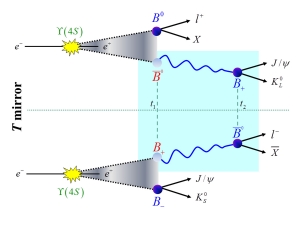A work by IFIC scientists, on the cover of Reviews of Modern Physics
The journal with highest impact factor in Physics, Reviews of Modern Physics, has chosen an article by our colleagues José Bernabéu and Fernando Martínez Vidal for the cover of its latest issue. The article, entitled Time-reversal violation with quantum-entangled B mesons has been published as one of the Colloquia of Reviews of Modern Physics, one of the Physical Review journals, belonging to the American Physical Society (APS). Their review articles offer insightful discussions of a research topic, review recent works and relevant articles and provide affordable introductions to postgraduate students and researchers from related areas. The shorter Colloquia describe recent progress in the frontiers of physics with impact in several fields. The authors chose to illustrate their work a figure that reflects the basics of the experiment, and the journal in turn selected it for the cover of its current issue.
This choice reflects the impact of this work, carried out by the BABAR collaboration at the SLAC laboratory (Stanford Linear Accelerator Center, USA) and published in late 2012 on the journal Physical Review Letters. The study, proposed and led by IFIC scientists, was at that moment selected by the editors of PRL as one of their Viewpoints in Physics, a recognition granted only to one hundred out of 18,000 articles published annually by the APS journals.
Other journals such as Physics Today, Nature, The Economist and Physics World reviewed and commented on these publications. The latter one, which each year selects the investigations considered the Top 10 Physics of the year, chose this result in the third position in 2012. The first position was occupied by the discovery of the Higgs boson by the ATLAS and CMS experiments at CERN.
The symmetries, or lack of them (their breaking, and the mechanisms leading thitherward) are a cornerstone of our understanding of the fundamental laws of nature. One of the most important symmetries, but also one of the most difficult to probe directly in the laboratory, is time reversal: we say that time reversal symmetry holds if evolution is reversible, that is, when we can recover causes from effects by applying the same physical laws, but in reverse order. Of course this "effects to causes" progression seems epistemologically inaccessible, and thence the difficulty to observe it in an experiment. To do so one has to devise a system where a process and its time-reversed are both realised.
When carried out in our familiar, macroscopic world, this sort of experiments always show that time-reversal symmetry holds. However, for certain specific systems of quantum-mechanical nature, it can be observed to break down. The movement of an isolated particle, be it classical or quantum, is time reversible; but when B mesons are considered, particles composed of a heavy b quark (dubbed "bottom" or "beauty") and a d ("down") antiquark, departures from time reversal can be detected. The key is to produce entangled pairs of B mesons; two particles are entangled when their quantum properties are not independent of each other, even if they are spatially separated. These two entangled B mesons can decay in two modes, and when one member of the pair chooses one mode the other member is forced to follow that mode too. But, and here comes the trick, the two modes are related: the surviving meson can oscillate, or transform, from one mode to the other, and this oscillation is the perfect field for observation of time reversal. Some B+ meson states will oscillate to B0, and some B0 to B+; by observing differences between the two directions we are probing time reversal violation without making the clock go back.
For more information you can find the original work at
Time-reversal violation with quantum-entangled B mesons, J. Bernabéu and F. Martínez-Vidal. Rev. Mod. Phys. 87, 165 – Published 23 February 2015.




















